Taxonomy and Terminology Change
After I posted a response to Knife Thursday's discussion on the definitions of customs v. midtechs v. production knives I continued to think about the problem. The more I did, the more I was unsatisfied with the answer. Additionally two other things happened. First, the ever talented Allen Elishewitz posted this thread on the USN (membership required). In case the link doesn't work search "Allen Elishewitz" and "Buyer Beware" on USN. Second, Dave Curtiss of Curtiss knives posted a meme pic on his Instagram thread, making fun of people that pay $900 for a midtech knife. These two things have led me to rethink how I view "custom knives" and forced me to rework how I talk about these blades. This was all ahead of the Shamwari review, and once I am done clearing the ground, I will explain why they are related.
There are tough cases, like a Liong Mah designed handmade custom, but the taxonomy can handle that--its just a handmade piece. The Todd Begg Field Grade Bodegas are more complicated. We don't know exactly how much Todd does on each knife, but merely supervising others is not enough to make it a midtech. It is probably just a very nice production knife.
Check the old article for how I thought the custom v. midtech v. production terms should be defined. Now here is the problem--customs aren't custom. The vast majority of "custom" knives aren't made for a specific person, they aren't unique. They are, generally, a set model that is handmade by a single person. And so the categories I laid out before don't work. There are true custom knives--knives made for a specific individual (I own one, the blade I designed and TT Pockettools made for me, see below), but this is generally not what knife knuts are talking about. People want a Brad Blount Arrestor or an Andrew Demko AD-10. These are knife models (patterns, to use the old term) handmade by a single person. But they are not customs in any sense of the word as used by regular people. They might be handmade, but they are not singular designs. They are similar in the vast majority of ways to all of the other Arrestors or AD-10 (that is, in fact, how we recognize them). That's the problem.
Now here is the solution. When knife knuts talk about "custom knives" we are distinguishing a given knife from a production knife based on two primary qualifications--how something was made and who made it. If something is made by robots it is different from a handmade knife. And if something is made by an army of people on an assembly line it is different from a single source knife. What knife knuts want is a knife that is handmade AND made by a single person--they generally do not get a knife that is unlike any other knife and handmade by a single person. So the word "custom" doesn't work. With those two axes--handmade and single source--laid out, we can solve this linguistic puzzle quickly and more correctly than in my first attempt.
Handmade, single source:
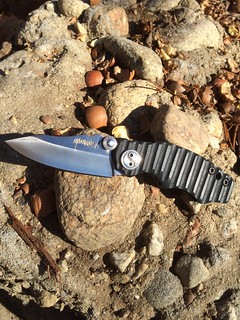
This is like a Yuna knife--it is a knife made with basic hand and power tools by a single person with all of the parts, even screws, made by that person. These are extremely rare. I know that Allen makes knives like this some of the time, but the only person I know of that ALWAYS makes all of his parts is Yuna. I suppose you could be a real stickler and require them to mine the ore to make the steel, but short of that, the creator of the knife made everything him- or herself.

This is like a Yuna knife--it is a knife made with basic hand and power tools by a single person with all of the parts, even screws, made by that person. These are extremely rare. I know that Allen makes knives like this some of the time, but the only person I know of that ALWAYS makes all of his parts is Yuna. I suppose you could be a real stickler and require them to mine the ore to make the steel, but short of that, the creator of the knife made everything him- or herself.
Single Source:
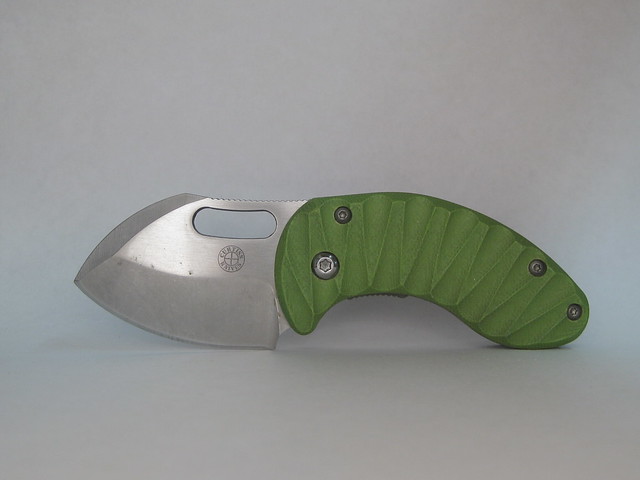
This is a Curtiss (that's his Nano above), Grimsmo, or Tighe knife--it is a knife made with advanced machinery by a single person. Obviously, the definition of "advanced machinery" is going to change over time, but the point is, Dave and Brian have machines that even hobbyist knife makers don't have. In many ways I think this is more impressive than a handmade knife, the Norseman is a beautiful blade, but it is different from what you get with a Yuna.

This is a Curtiss (that's his Nano above), Grimsmo, or Tighe knife--it is a knife made with advanced machinery by a single person. Obviously, the definition of "advanced machinery" is going to change over time, but the point is, Dave and Brian have machines that even hobbyist knife makers don't have. In many ways I think this is more impressive than a handmade knife, the Norseman is a beautiful blade, but it is different from what you get with a Yuna.
Handmade:
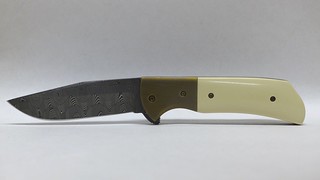
This is like a Gavko or Tuff Knives knife--it is a knife where the majority of parts and processes are done by a single person, but some things, like cutting lockbar blanks, screw making, and/or heat treat is done by someone else. The vast majority of the "custom" knives out there right right fall into this category and it is obviously a spectrum--Charles Gedraitis imports only his screws, as does Steve Karroll, while Gareth Bull, Gavko, and Tuff Knives all have lock bars water jetted.

This is like a Gavko or Tuff Knives knife--it is a knife where the majority of parts and processes are done by a single person, but some things, like cutting lockbar blanks, screw making, and/or heat treat is done by someone else. The vast majority of the "custom" knives out there right right fall into this category and it is obviously a spectrum--Charles Gedraitis imports only his screws, as does Steve Karroll, while Gareth Bull, Gavko, and Tuff Knives all have lock bars water jetted.
Midtech:
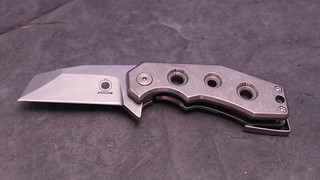
This is like my GMT Stubby Razel or the Tolk--it is a knife where the majority of parts and processes are done by someone other than the knifemaker, but the final steps--lock fitting, grind, and the like, are done by the knifemaker. There is a spectrum in handmade knives and at some point, let's say 50.1% to be arbitrarily specific, that the knife ceases to be a handmade object and more of a production piece. So long as the knifemaker still lays hands on each blade in a meaningful way, more than say, assembling finished parts, its a midtech; if not, it is a production piece.

This is like my GMT Stubby Razel or the Tolk--it is a knife where the majority of parts and processes are done by someone other than the knifemaker, but the final steps--lock fitting, grind, and the like, are done by the knifemaker. There is a spectrum in handmade knives and at some point, let's say 50.1% to be arbitrarily specific, that the knife ceases to be a handmade object and more of a production piece. So long as the knifemaker still lays hands on each blade in a meaningful way, more than say, assembling finished parts, its a midtech; if not, it is a production piece.
Production:
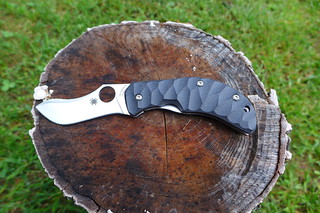
This is like the Spyderco Zulu--it is a knife where the design and production of the knife are handled by entirely different people or groups of people. In the most extreme you get something like Cold Steel knives or the OEM blades from Spyderco, Kershaw, or Boker--the designer creates "blueprints" sends them to the big company and they then outsource them to an OEM overseas. Cold Steel, to my knowledge, does not make ANY knives, they just handle the design and marketing of them. Spyderco, Kershaw, and Benchmade still make some knives, but all three outsource designs to OEMs for production. If you wanted to be unnecessarily specific you could distinguish between in-house productions like the Spyderco Paramilitary 2 (designed in the US by Spyderco and made in the US also by Spyderco) and outsourced productions (like the Kershaw Zing G10, designed by RJ Martin, produced by Kershaw and made by an overseas OEM).

This is like the Spyderco Zulu--it is a knife where the design and production of the knife are handled by entirely different people or groups of people. In the most extreme you get something like Cold Steel knives or the OEM blades from Spyderco, Kershaw, or Boker--the designer creates "blueprints" sends them to the big company and they then outsource them to an OEM overseas. Cold Steel, to my knowledge, does not make ANY knives, they just handle the design and marketing of them. Spyderco, Kershaw, and Benchmade still make some knives, but all three outsource designs to OEMs for production. If you wanted to be unnecessarily specific you could distinguish between in-house productions like the Spyderco Paramilitary 2 (designed in the US by Spyderco and made in the US also by Spyderco) and outsourced productions (like the Kershaw Zing G10, designed by RJ Martin, produced by Kershaw and made by an overseas OEM).
Custom:
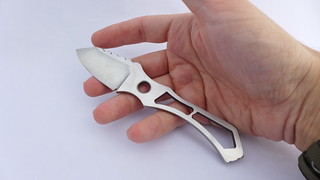
A bespoke piece, unique and made for a single person. You can have a handmade, single source custom, a single source custom, and so on...
Mods:
You can have modded versions of the above as well, though most folks mod production knives. Generally I think of mods in two camps--light and heavy. A light mod is something like a scale swap or refinish on the blade. Here is my old Buck Advantage, modded by Thuff Thumbz:
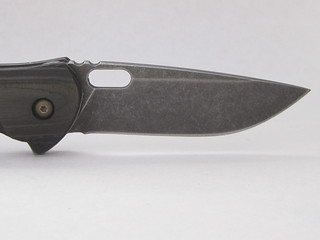
A heavy mod involves a rework of the basic design, something like Smock Knives Mini Southard:
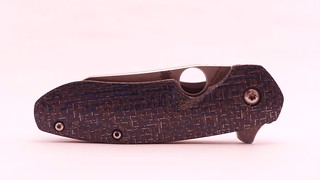

A bespoke piece, unique and made for a single person. You can have a handmade, single source custom, a single source custom, and so on...
Mods:
You can have modded versions of the above as well, though most folks mod production knives. Generally I think of mods in two camps--light and heavy. A light mod is something like a scale swap or refinish on the blade. Here is my old Buck Advantage, modded by Thuff Thumbz:

A heavy mod involves a rework of the basic design, something like Smock Knives Mini Southard:

There are tough cases, like a Liong Mah designed handmade custom, but the taxonomy can handle that--its just a handmade piece. The Todd Begg Field Grade Bodegas are more complicated. We don't know exactly how much Todd does on each knife, but merely supervising others is not enough to make it a midtech. It is probably just a very nice production knife.
Examining this taxonomy again has led me to a single point--the problem isn't with the terms, but the lack of disclosure on the part of knifemakers. We, the customers, should know just how much a knife maker does when producing a knife, especially midtechs. The better makers are very forthcoming with this information--Graham was up front with how much he did on the GMT Stubby Razels (lockbar fitting and edge grinding) and Gareth was very up front about the Shamwari when I asked him. But some are less up front and that, more than the terms themselves, is a problem.
The Shamwari is a bit of an anomaly in the knife world--it is made in waves or batches like custom lights are. This means that instead of one or two at a time, the Shamwaris are all made at once. As a woodworker I can see the utility in this. When I make something with drawers I don't make one drawer and fit it in the carcass, then go back and make another. I batch them out. The efficiency of performing the same task with the same tools and same set up is undeniable. I can make four drawers in 150% the time it takes me to make one. The set up and lay out are BY FAR the most time consuming steps in the process. The actual cutting and fitting is relatively quick. So making knives in batches of 10 or 12 makes sense. In fact, I don't know why more makers don't do this. If you listen closely you'll hear a common refrain among knife makers--they get tired of doing the same thing over and over. Maybe if they make blades in batches, the monotony would be less.
The second thing about the Shamwaris is that they have pre-cut lock bars. Everything else, the blades, the handles, the clips, even the washers, are handmade by a single person. The only other part made by someone else are the screws (screws are almost always made by someone else, except on a Yuna and a few others). As such, I think it is fair to classify the Shamwari as a handmade knife, under the taxonomy above.
The industry is as a weird point because of the massive influx of cash and attention. Production companies are making truly superior knives, like the ZT0454. Conversely, everyone and their mother is claiming to be a custom knife maker and these folks are putting out some crude stuff. Finally there is the most pernicious of problems--custom makers releasing midtechs. Allen is right--assembling finished parts does not make you a knife maker and that does not make a knife a midtech, any more than assembling furniture from pieces in a box from Ikea makes you a woodworker. The knife maker has to do something important on the knife to make it a midtech. Otherwise it is a production blade.
Again this all has to do with disclosure. The more disclosure the better, for everyone. Calling things handmade when they are midtechs or midtechs when they are production knives devalues all of the categories of knives. Hademade knives are special. They demand a lot of work and they should command a lot of money. Calling things that aren't handmade devalues that. In the long run, the knife maker that does this hurts him or herself. If they start out making "handmade" knives that are really midtechs, but then later develop the skill to do real handmade stuff, how are they going to tell their customers and make people think their new, actual handmade knives are worth paying a premium? The answer is they can't.
Disclosure is important, but hopeful a more clear and consistent language will help a bit. I'll try to stick to these categories in reviews and hopefully they'll catch on in the knife community, but I doubt it. Playing fast and loose with language can make a person a few extra bucks, even if it hurts them in the long run.
The industry is as a weird point because of the massive influx of cash and attention. Production companies are making truly superior knives, like the ZT0454. Conversely, everyone and their mother is claiming to be a custom knife maker and these folks are putting out some crude stuff. Finally there is the most pernicious of problems--custom makers releasing midtechs. Allen is right--assembling finished parts does not make you a knife maker and that does not make a knife a midtech, any more than assembling furniture from pieces in a box from Ikea makes you a woodworker. The knife maker has to do something important on the knife to make it a midtech. Otherwise it is a production blade.
Again this all has to do with disclosure. The more disclosure the better, for everyone. Calling things handmade when they are midtechs or midtechs when they are production knives devalues all of the categories of knives. Hademade knives are special. They demand a lot of work and they should command a lot of money. Calling things that aren't handmade devalues that. In the long run, the knife maker that does this hurts him or herself. If they start out making "handmade" knives that are really midtechs, but then later develop the skill to do real handmade stuff, how are they going to tell their customers and make people think their new, actual handmade knives are worth paying a premium? The answer is they can't.
Disclosure is important, but hopeful a more clear and consistent language will help a bit. I'll try to stick to these categories in reviews and hopefully they'll catch on in the knife community, but I doubt it. Playing fast and loose with language can make a person a few extra bucks, even if it hurts them in the long run.
